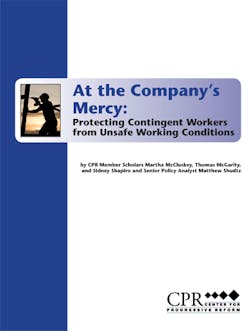7 Strategies to Improve Safety for Contingent Workers
An increasing number of U.S. employees are employed as “contingent” workers, an arrangement that can expose them to occupational safety and health risks not experienced by a permanent work force. A new report from the Center for Progressive Reform (CPR) offers seven strategies to protect continent employees from unsafe working conditions.
The white paper “At the Company’s Mercy: Protecting Contingent Workers from Unsafe Working Conditions,” by CPR member scholars Martha McCluskey, Thomas McGarity, Sidney Shapiro and Senior Policy Analyst Matthew Shudtz, highlights the occupational challenges facing contingent workers in the United States and suggests strategies to improve their working conditions.
“Their shared experience is one of little job security, low wages, minimal opportunities for advancement, and, all too often, hazardous working conditions,” the white paper says of workers whose employment is contingent upon short-term fluctuations in demand for employees. “When hazards lead to work-related injuries, the contingent nature of the employment relationship can exacerbate the negative consequences for the injured worker and society.”
Employers of contingent workers often do not pay for workers’ compensation or health insurance and can simply hire replacements when workers are injured – factors that give these employers little financial incentive to eliminate safety hazards or help injured workers return to work. Additionally, employers sometimes misclassify contingent workers as “independent contractors” in order to claim the workers will pay their own taxes and insurance – a practice that reduces the employer’s expenses while also removing the incentive to create a safe workplace, the paper states.
The white paper includes case studies on contingent workers in four industries: farming, construction, warehousing and hospitality. The construction industry, for example, employs a disproportionate number of contingent workers in the United States. Most of these workers are young men, and many are Hispanic or Latino, performing dangerous jobs that have a high risk for falls, nail-gun injuries, musculoskeletal injuries and more.
7 Ways to Protect Contingent Workers
The CPR white paper offered seven strategies to ensure the contingent work force is protected:
2. Empower workers with a right-to-act.“Under current law, workers lack the power to commence legal action on their own accord against an employer that is breaking the law; instead, they must make a formal complaint to OSHA and await the agency’s response ...Workers need to be able to wield power that is proportionate to their huge stake in the game. That power should come in the form of an amendment the OSH Act that would create a legal vehicle for enforcing worker rights against employers,” the paper asserts.
3. Strengthen OSHA enforcement. The paper claim that “OSHA could make a significant impact on health and safety in contingent workers’ lives through modifications to existing enforcement policies ... In addition, OSHA has the ability to test the new policies for effectiveness by implementing them in discrete geographical areas or selected industries.”
4. Create ergonomics standards. “Since ergonomic hazards pose significant risks in industries and occupations that employ many contingent workers, OSHA should establish regulations to eliminate those hazards,” the paper states. “...OSHA could issue a series of industry-specific ergonomics rules, geared toward particular hazards. Starting with industries that employ a significant number of contingent workers would lead to better protections for millions of workers without coming close to the alleged $4 trillion price tag that prompted the congressional veto of the broader standard in 2001.”
5. Reform voluntary and consultation programs. “As the contingent workforce grows, OSHA has an obligation to revisit existing programs to ensure that they meet the needs of contingent workers,” the paper asserts. “First, OSHA should revise the minimum criteria that companies must meet to be part of the Voluntary Protection Program (VPP) ... Given the health and safety concerns raised by employer decisions to place contingent workers in new and high-hazard jobs, VPP entry criteria should be revised to require that VPP employers only use contingent workers in low-hazard occupations such as clerical work.”
6. Build a case to close statutory loopholes. “OSHA should also determine if there are data that support closing loopholes in the OSH Act that limit the statute’s applicability to domestic workers and farmworkers on small farms,” the white paper added.
7. Improve foreign-language capabilities. According to the white paper, “the high number of Hispanic workers in the contingent workforce suggests that language barriers can create challenges for education and training ... In addition to hiring more bilingual inspectors, OSHA must increase the foreign-language capabilities of staff who develop education and training materials. The agency should establish a goal of making all of these materials available in multiple languages and formats, reflecting not only the spectrum of workers’ native languages, but also differences in culture and literacy.”
“As the contingent worker population grows, the occupational safety and health community will have to adapt,” the paper concluded. “OSHA can lead the way with new rules and better enforcement, but the agency will also need the help of other advocacy organizations, from union-affiliated campaigns to worker centers to faith-based groups. Because the contingent workforce is particularly vulnerable to unfair treatment and poor working conditions, empowering these workers to act will take the support of many advocates.”
CPR’s “At the Company’s Mercy: Protecting Contingent Workers from Unsafe Working Conditions,” may be download as a PDF.
About the Author

Laura Walter
Laura Walter was formerly senior editor of EHS Today. She is a subject matter expert in EHS compliance and government issues and has covered a variety of topics relating to occupational safety and health. Her writing has earned awards from the American Society of Business Publication Editors (ASBPE), the Trade Association Business Publications International (TABPI) and APEX Awards for Publication Excellence. Her debut novel, Body of Stars (Dutton) was published in 2021.


